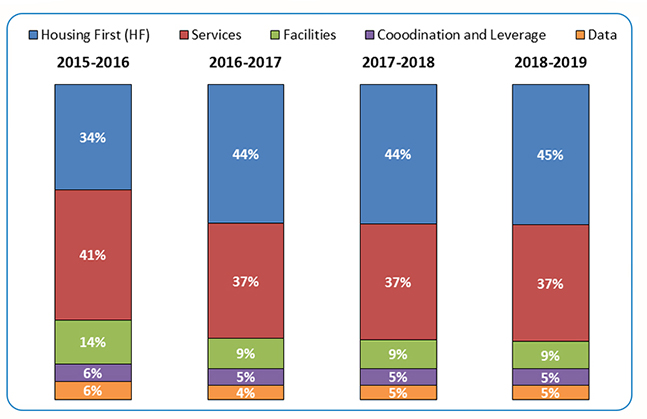Community Plan 2014-2019: Small Designated Communities
The Homelessness Partnering Strategy (HPS) is a community-based program aimed at preventing and reducing homelessness by providing direct support and funding to 61 designated communities across Canada, and by supporting them in the implementation of a Housing First (HF) approach to address chronic and episodic homelessness.
This portrait is a summary of the HPS 2014-2019 community plans submitted by small designated communities Footnote 1 . This summary complements the large city analysis, and it provides aggregated and comparative figures of the small designated communities.
Findings
Communities are inclusive and ready to address gaps
Communities held broad consultations to develop their HPS Community Plans including various stakeholders and sectors involved in addressing homelessness issues. The Community Advisory Board (CAB) of each community also includes broad representation across sectors. However, in these communities, representation could be broadened by including landlord associations, people with lived experience of homelessness, the police/corrections sector, and those involved in the delivery of income supports. Consequently, most communities indicated sectors where their CAB should include representation.
Communities are partnering
To demonstrate that they have mobilized partners to contribute to their homelessness efforts, communities must identify at least one dollar from other sources contributing towards to their homelessness efforts for every dollar of their annual funding allocation under the HPS Designated Communities funding stream. In their plans, communities have identified funding from various partners such as: governments (Federal, Provincial/Territorial or Municipal/Regional); public institutions, such as hospitals, schools or universities; Aboriginal organizations; private sector organizations; and not-for-profit/charitable sector organizations, such as foundations. Community Entities (CE) are required to report annually on the actual amount received.
Figure 1 shows that the community contribution in the small designated communities mainly comes from Provincial / Territorial governments.

Text description of figure 1
The data in Figure 1 is based on information taken from the 2014-2019 HPS community plans. The figure shows various types of funders outside of HPS who contribute to the community contribution and indicates the percentage of community contribution amount outside of HPS funding coming from each of the type of funders in small designated communities across Canada.
- 68% of the community contribution amount is expected to come from the Provincial or Territorial government;
- 16% of the community contribution amount is expected to come from the City or Municipality;
- 9% of the community contribution amount is expected to come from the not-for-profit or charity sector;
- 1% of the community contribution amount is expected to come from foundations;
- 0.2% of the community contribution amount is expected to come from the for profit or private sector;
- 5% of the community contribution amount is expected to come from other sources.
Communities are implementing Housing First from varying starting points
As part of the community planning process, communities identified priorities for local HPS investments. Many small designated communities with an HF investment target starting on April 1, 2016 have chosen to allocate investments to HF in the first year (2014-2015), focusing on the chronically and episodically homeless population groups.
Figure 2 shows how small designated communities will allocate their HPS funding (excluding Community Entity administrative cost) among the priorities from 2014 to 2015. Investments in small designated communities will focus mostly on activities related to services, HF, and facilities. Small designated communities without an HF investment target tended to invest more in services (66% on average), while small designated communities with an Aboriginal homeless plan invested more in facilities (33% on average).
Additionally, compared to larger cities, Figure 2 shows that small designated communities appear to invest a larger portion of HF funding in HF readiness and a smaller portion in case management services.
Figure 2 outlines the investments small designated communities and communities with Aboriginal Homelessness plans expect to make in each priority from 2015 to 2019. Small designated communities with a HF investment target will generally invest over 50% on HF. Communities without a HF investment target plan to invest 20% on HF. In small designated communities with an Aboriginal Homelessness plan, 40% of their allocation will be invested towards HF.

Text description of figure 2
The data in Figure 2 is based on information taken from the 2014-2019 HPS community plans. The figure shows the HPS 2014-2015 annual investments by priorities and shows the percentage of HPS funding allocation that is dedicated to each priority and Housing First activity in small designated communities across Canada.
Small designated communities plan to invest:
- 4% of their HPS funding allocation toward the priority on data;
- 5% of their HPS funding allocation toward the priority on coordination and leverage;
- 20% of their HPS funding allocation toward the priority on facilities;
- 49% of their HPS funding allocation toward the priority on services;
- 21% of their HPS funding allocation toward the priority on Housing First. Of this allocation toward the priority on Housing First:
- 29% will be dedicated to the Housing First readiness activity;
- 13% will be dedicated to the intake and assessment activity;
- 17% will be dedicated to the connection to permanent housing activity;
- 34% will be dedicated to the case management services activity;
- 6% will be dedicated to data, tracking, and monitoring.

Text description of figure 3
The data in Figure 3 is based on information taken from the 2014-2019 HPS community plans. The figure shows the HPS annual investment from 2015 to 2019 by priorities among small designated communities across Canada and shows the percentage of HPS funding allocation that will be dedicated to each priority in each year.
In 2015-2016, small designated communities plan to invest:
- 34% of their HPS funding allocation toward the priority on Housing First;
- 41% of their HPS funding allocation toward the priority on services;
- 14% of their HPS funding allocation toward the priority on facilities;
- 6% of their HPS funding allocation toward the priority on coordination and leverage;
- 6% of their HPS funding allocation toward the priority on data.
In 2016-2017, small designated communities plan to invest:
- 44% of their HPS funding allocation toward the priority on Housing First;
- 37% of their HPS funding allocation toward the priority on services;
- 9% of their HPS funding allocation toward the priority on facilities;
- 5% of their HPS funding allocation toward the priority on coordination and leverage;
- 4% of their HPS funding allocation toward the priority on data.
In 2017-2018, small designated communities plan to invest:
- 44% of their HPS funding allocation toward the priority on Housing First;
- 37% of their HPS funding allocation toward the priority on services;
- 9% of their HPS funding allocation toward the priority on facilities;
- 5% of their HPS funding allocation toward the priority on coordination and leverage;
- 5% of their HPS funding allocation toward the priority on data.
In 2018-2019, small designated communities plan to invest:
- 45% of their HPS funding allocation toward the priority on Housing First;
- 37% of their HPS funding allocation toward the priority on services;
- 9% of their HPS funding allocation toward the priority on facilities;
- 5% of their HPS funding allocation toward the priority on coordination and leverage;
- 5% of their HPS funding allocation toward the priority on data.
Communities are addressing the needs of homeless and at-risk population groups
The Community Plan also asked communities to select priorities not related to HF. Small designated communities expect to focus on various activities to support population groups who are homeless or at imminent risk of homelessness. More than two-thirds of the small designated communities identified the following activities for their priorities not dedicated to HF: liaise and refer to appropriate resources, housing loss prevention, connecting clients to income supports, housing placements (outside HF), and life skills development (e.g. budgeting, cooking).
While HF targets chronic and episodic homelessness, small designated communities have identified specific populations for non-HF activities. The main groups identified by most small designated communities in their non-HF service priorities include: the general population, Aboriginal people, youth, families and children.
Finally, small designated communities are also addressing the needs of key target populations through capital projects not related to HF (i.e. building, renovating or purchasing facilities). Through this priority, the main groups targeted include: the general population, Aboriginal people, youth, and people with a mental health issue.
Conclusion and next steps
Through their community planning process, small designated communities have demonstrated an early interest to implement HF under HPS. For the 2014-2019 period, communities are implementing projects that best address key priorities. A mid-year dialogue with communities is underway to assess progress and determine what additional supports communities may need to successfully implement HF and meet their target. At the end of each year, communities will report on project outcomes and submit an annual Community Plan update.
Report a problem on this page
- Date modified:
